![]()
Page 13b
Belmond, IA Tractor Show
For many of the collectors and owners at this show, the hobby is all about restoration and preservation. But for some, as you will see below, it is about presentation and the image of the days gone by. We were reminded at this show that in the first half of the 20th century, many farmers did not own all the equipment needed to harvest their crop. One of the sub-contracted parts of the harvest was threshing and corn shelling. Sometimes it was a community of farmers sharing in the work and equipment, and for others it was hiring the custom sheller that worked their area. This old car, sheller, and stationary engine made us think about what the traveling corn sheller would have looked like. This collector has not restored any of the equipment but seems inclined to keep it working as it would have been in the early part of the 20th century.
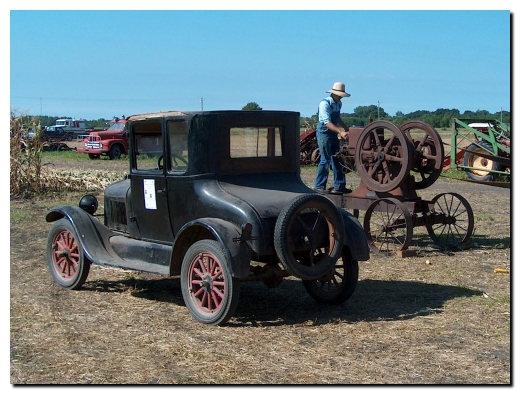
Stationary power for corn sheller
As we watched, the operator prepared this old engine and then spun the flywheel to get it started. We found these old engines interesting in how infrequently they fire and how quiet they are when they do. It takes a lot of tinkering to get the engine running smoothly, but once started they provide very steady power that is delivered via the large flat belts. In this case the sheller is between the engine and corncrib and must be hand fed. It deposits the cobs and shucks out the backside in a large pile. The engine is running but the camera's shutter stopped the flywheel's motion.

Stationary motor powering a hand fed sheller
As part of the same display we saw a newer model sheller in operation. It was a Minneapolis-Moline and was powered by a more modern tractor. It used the drag in front of the crib and separated the cobs and shucks into separate piles. As a youngster I worked a couple summers for a farmer in Jackson, MN and he hired this work done in a similar manner. His contractor had a larger sheller and the drags were assembled and fed into a drag lane under the crib. My job was to crawl into the crib and keep the corm moving into the drag. I can personally attest to the fact that even though shelling like this was certainly much better than when done totally by hand, it was still a hard days work.

Minneapolis-Moline sheller with drags
As we returned from the corn shelling and silage cutting display areas we passed the second of two sawmills. This one was powered by a steam engine and although smaller in size was still one very powerful machine. The steam engine operator remained on the engine during the cutting process as he was in control of the power take-off that ran the mill. We watched as smaller logs were cut and left when they had to sharpen the large blade and perform some other minor maintenance.
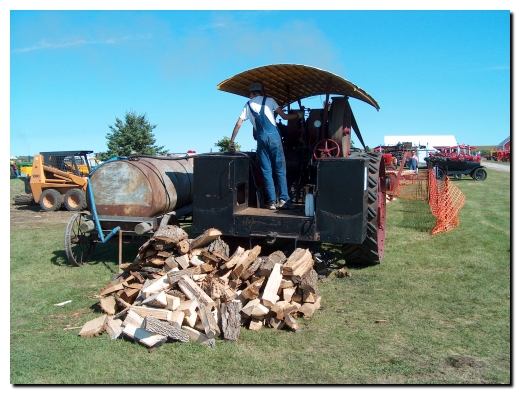
Steam engine to power smaller sawmill
From this angle you can see the steam engine and sawmill in operation. The sawdust piles are made by a small lawnmower sized engine running a chain style drag link that pulls sawdust from under the blade. Workers equipped with a grain scoop provide the power to move the pile back further.
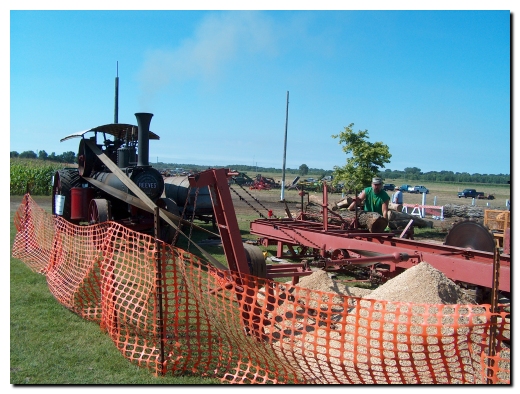
Steam powered sawmill in operation
The facility that hosted this event is an old farmstead with a modern art gallery located a little way from this old farmhouse. The house is open for inspection and is outfitted with period furniture and volunteers making butter and quilting. Outdoors in the front yard workers had an old enameled cook stove operating and making apple fritters.
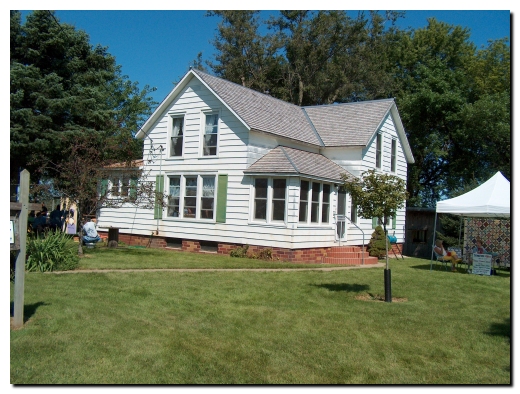
Original home on this farmstead
Around the side of the house a volunteer was making apple cider with a hand operated cider press and fresh apples. Samples of the cider, like the fritters, are free to visitors.

Apple Squeezen
Under the shade of the trees in the backyard was a huge display of working (and some non-working) stationary power engines and many other gas powered devices. This front row of Maytag washing machines all featured the small foot peddled started engines. Many of these had been restored to their original condition.

Gas-powered Maytag washing machines
This final picture will represent the many engines we saw during our visit to the show. This Waterloo Boy engine made by a company right here in Iowa was really something to see and hear. It has an open topped chamber that is filled with water to cool the cylinder and rests on wood rails and steel wheels. I watched as the operator prepped and then started the motor. I found a website about this style motor that commented on the “chuffing” sound it makes as it runs. It fires slow enough to count the ignition cycles and he told me it would have been used to power pumps, feed grinders, and anything else the farmer could “belt it up to.”
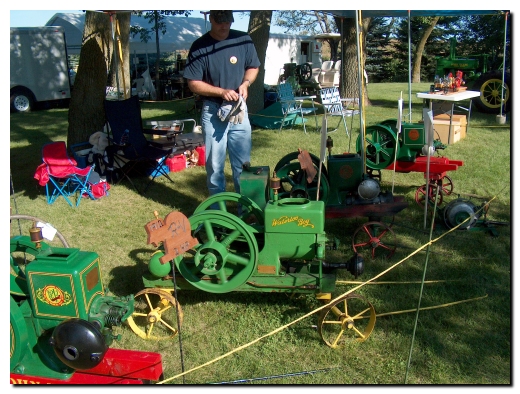
Waterloo Boy stationary engine
We will conclude this page with a brief editorial comment. It isn’t often that we promote an event, especially when we have nothing to do with it except attend. But we can state with no reservation that this is one of the best local festivals or events we have attended. The grounds were clean, well laid out, and everyone on the place seemed to go out of their way to make the visit of great value. There were reasonably priced food stands by local churches and youth groups, clean modern restroom facilities, and convenient parking. We will more than likely visit again, we were told this is a yearly event on the third full weekend of August. Admission was $5.00 per person and parking was free!
Return to our first page